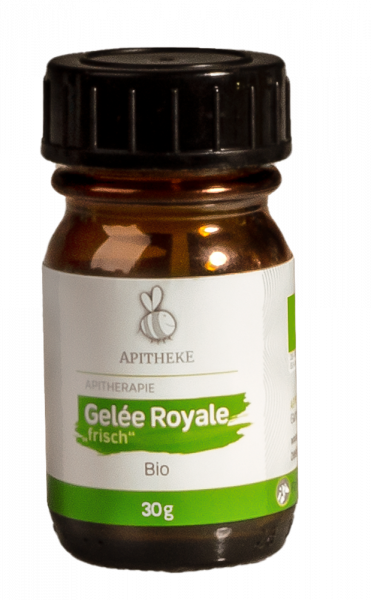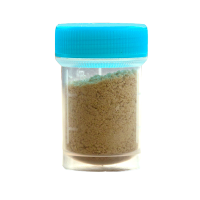
| Quantity | Unit price | Basic price |
|---|---|---|
| To 1 | €19.00 | €633.33 / 1 Kilogram |
| From 2 | €17.00 | €566.67 / 1 Kilogram |
| From 3 | €16.00 | €533.33 / 1 Kilogram |
| From 4 | €15.00 | €500.00 / 1 Kilogram |
| From 5 | €14.80 | €493.33 / 1 Kilogram |
Prices incl. VAT plus shipping costs
Ready to ship today,
Delivery time appr. 1-3 workdays
- Order number: GR-1000
- Info: Shipment in Germany and Austria only!
- Info: Organic Quality
Organic Royal Jelly – 30g pure Energy for direct consumption
Can also be mixed with honey, best nibbled in the morning before breakfast
Royal Jelly, the juice that produces queens.
Nearly all women know Royal Jelly as a cosmetic compound which regenerates skin tissue and visibly regenerates skin. Taken as a dragee, Royal Jelly is a kind of cosmetic from the inside, widely known for its building, strengthening and regenerating effect.
Word got around that the feeding juice – since this is what Royal Jelly is – contains substance that vitalize, renew and therefore combat the aging process.
This product has to be kept in the fridge!
Shipment in Germany and Austria only!
Study.
What has made bees able to survive for millennia can also be useful and helpful for human kind, this thought should be considered. We are therefore not surprised, that naturopathy has long discovered and investigated the medical usages of Royal Jelly with great success that go far beyond simply cosmetic effects.
Did you know that
- all bee larvae get fed with Royal Jelly in the first 2-3 days of their lives, but only the queen receives this feed her life long? Her rapid physical development, her long lifespan and the remarkable action of laying up to 2000 eggs per day are a result of this diet.
- the Royal Jelly used by the cosmetic industry is an almost exclusively synthetic product? Natural Royal Jelly is absolutely rare. Bee keepers can only steal it from their bees a few drops at a time, since it is their livelihood.
- that the hormones in Royal Jelly are female hormones? This explains the productivity of the queen bee in her untiring laying of eggs.
- Rumanian specialists have discovered a bee product similar to Royal Jelly called “Apilernil”. It is a product from the male larvae whose effect is comparable to Viagra.
How does Royal Jelly develop?
The nursing bees produce the feeding juice for the queen in a gland on the upper jaw. It is remarkable that nursing bees are exclusively very young animals of 4 up to 12 days of age. This makes sense: like all young beings they possess unhampered energy clean cells. This influences directly the quality of the feeding juice they produce and is the reason, why the queen enjoys a very long life on this food. (a queen bee reaches a 60 – 70 times higher age than the normal working bee)
The nursing bees themselves feed exclusively on honey and fermented pollen (bee’s bread) and produce out of this a wondrous and mysterious mix of amino acids, carbohydrates, fats, vitamins minerals etc. which we call Royal Jelly. The queen bee lives exclusively of this elixir.
Thanks to its intake she is able to lay as many eggs as corresponds to her body weight.
Nursing bees prepare this feeding juice for her by eating a lot of pollen and thereby stimulating their feeding glands. But also every working bee receives this juice in the first 3 days of her life.
Male larvae receive an especially large amount of it. Royal Jelly has also the function of baby food in the hive. The little bee larvae grows very fast thanks to this exceptionally good food.
This impressive effect of Royal Jelly is based on its exceptional high density of nutrients and outright amazing active components of the casing.
Up to today the countless hormones, enzymes coenzymes and vitamins just as the enormously high content of minerals are not entirely analytically definable. We are especially far from being able to clearly recognize and formulate the comprehensible coherences.
A further wondrous effect lies in the continuous intake of Royal Jelly. If a female bee larvae receives Royal Jelly beyond the 3rd day, she develop into a queen. This means consequently that every female larvae of a hive could become a queen, if only enough royal Jelly is available during her development.
Through this mechanism it is possible for the bee keeper to harvest Royal Jelly. Bee colonies that are optimally supplied want to develop daughter queens at the height of their development to be able to divide their colony into two or more daughter colonies.
The ability to survive depends in critical moments always on the performance of the young queen. Some of the female larvae receive therefore an especially large amount of Royal Jelly. They receive so much juice that they practically float on it.
Out of this abundance the bee keeper can suck off a large drop from every queen larvae every day. However, this is only possible in May and June. The other daily produced Royal Jelly cannot be harvested since it is used immediately by the bees. Therefore Royal Jelly has to be obtained in the spring, the most work intensive time for the bee keeper.
Due to its characteristics Royal Jelly is, like every product of the bees, superbly able to be stored. In the fridge it keeps for up to a year without problems. Frozen at -18°C it keeps for many years.Royal Jelly has many uses.
If you take it orally, watch out for the pH value, it really puckers your mouth if you are not a fan of sour tastes. It is therefore recommended to mix with honey or other treats like muesli, yoghurt, soft cheese or simply spread on bread. A guideline for the daily dose is an average of about 120 to 180 mg over a treatment time of two months a year.
| Target group: | Women, men, Kids |
| Color: | Natural product - Color may vary, yellowish |
| Notices: | Dietary supplements do not replace balanced and healthy diet, Do not use a metal spoon, Always keep in the fridge |
| Origin: | Thailand |
| Taste: | sour, slightly burning |
| Ingredients: | Royal Jelly |
| Special: | Also suitable for people of Islamic origin. |
 Apilarnil -lyophilized (freeze dried) pure...
Apilarnil -lyophilized (freeze dried) pure...
